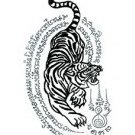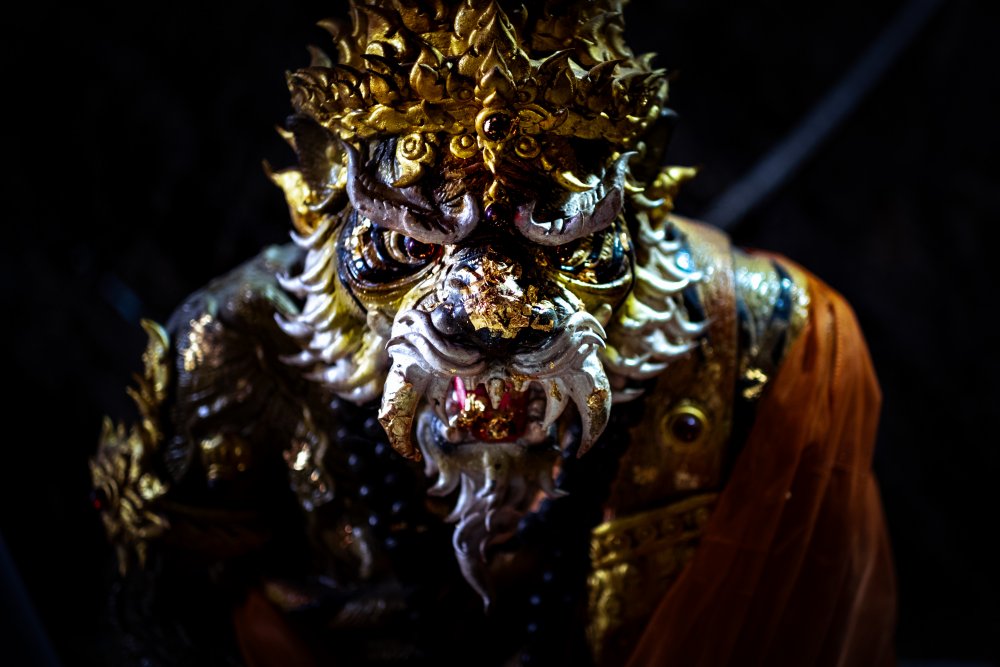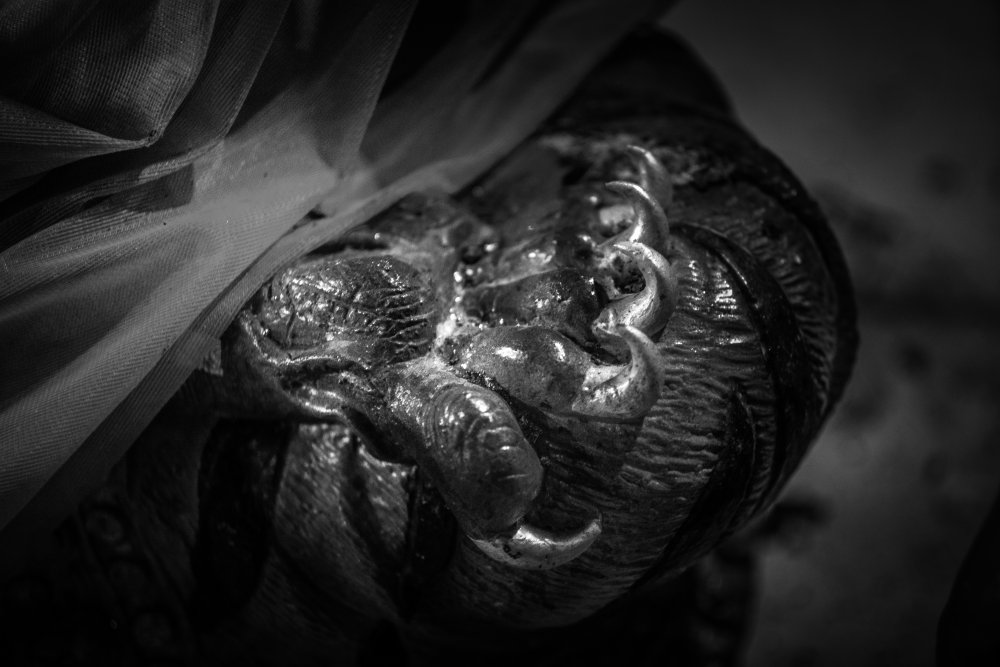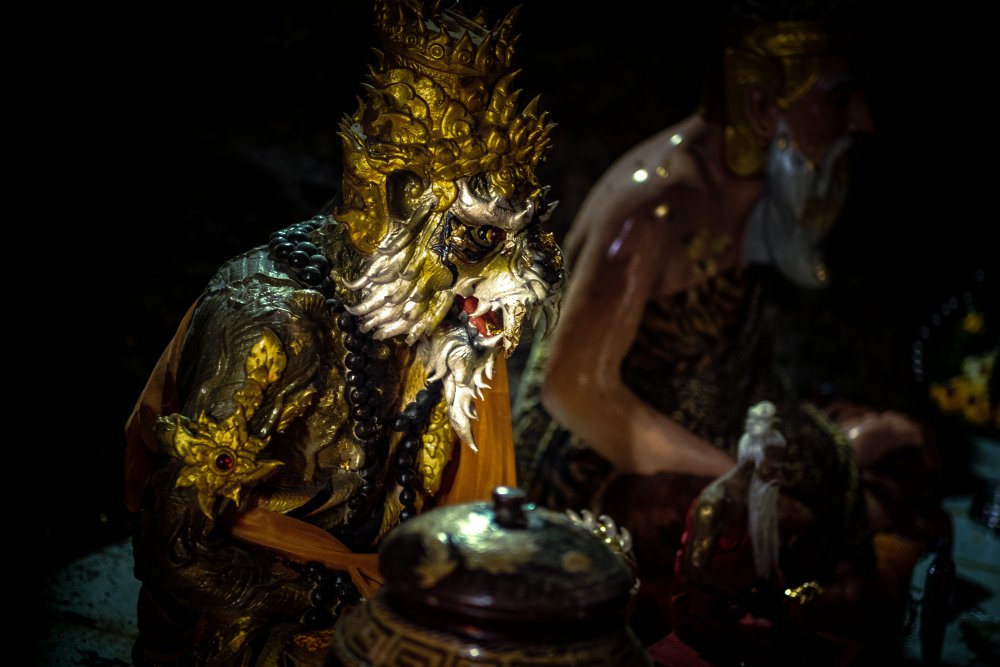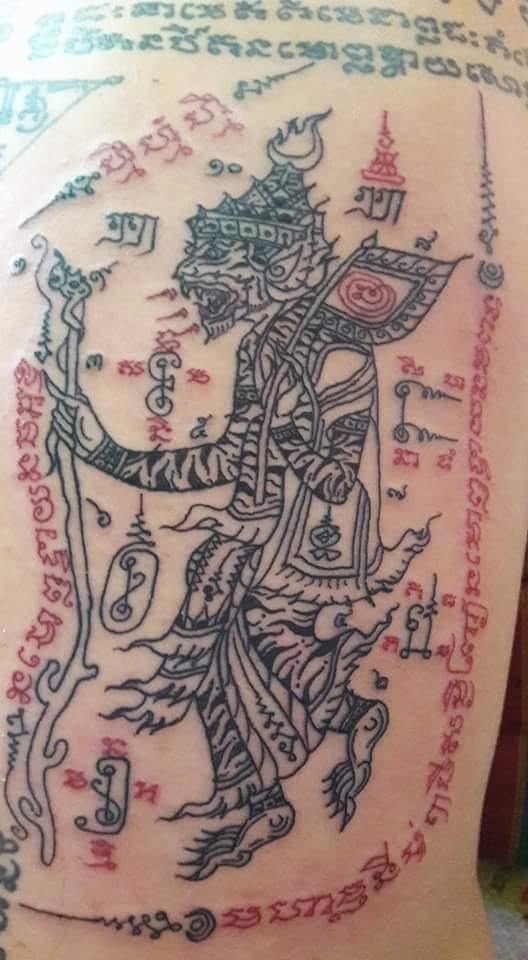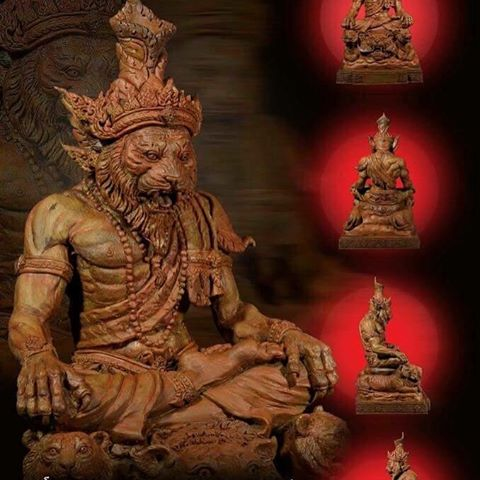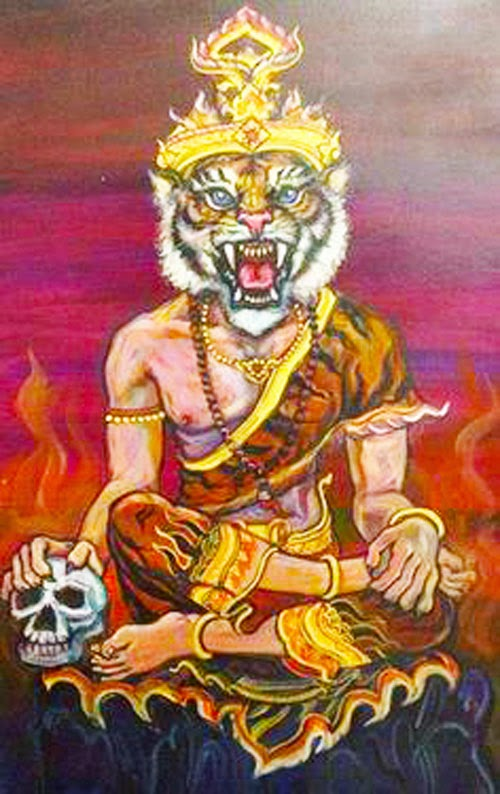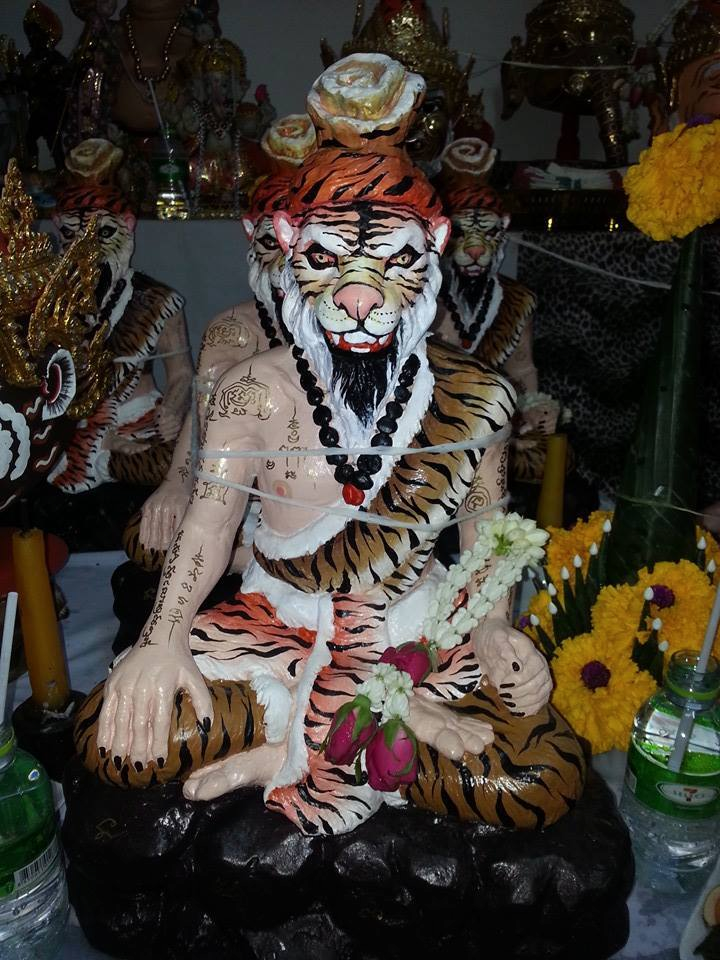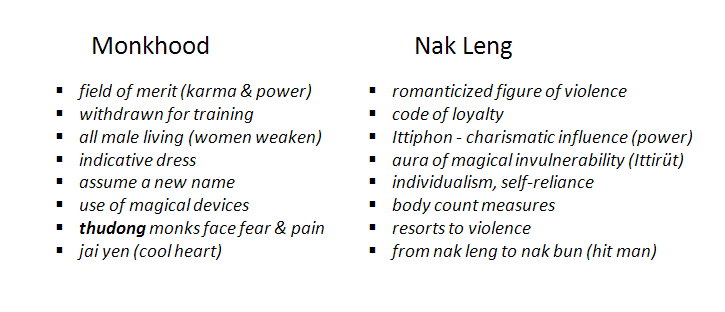Leaderboard
Popular Content
Showing content with the highest reputation on 11/26/2020 in all areas
-
On our visit to Wat Khao Aor in Phatthalung, a 900 year old temple that was built around a sacred cave that likely featured worship for a much longer time. There are stories about the elephant-like shapes in the stone of the cave walls for instance. In that cave now are a host of spiritual figures/statuary as the cave has been a place of organized ceremonial retreat, mediation & merit-making for centuries. Among these figures is a Tiger Ruesi, something that has long captured my imagination, especially as I try to figure out the affective/spiritual path of the Nakmuay in Thailand, the particular way in which Muay Thai mitigates, translates, hones & even amplifies violence, alchemizing it into a artform, and a possibly a minor practice of transcendence. The Tiger Ruesi - and there are many differing tales, and likely differing Ruesi with a Tiger head, is a spiritual (magical) hermit who advanced in his (dark?) arts so thoroughly his head transformed into one of a tiger. One such tale of this event involved dualing Ruesi testing their magic upon each other, but whatever the stories, the figure itself expresses the incredible harmony/dichotomy of a holy man holding both the ferocity of a Tiger's Truth (energy), and the Buddhist epitome of equanimity. He, like the figure itself, feels like a living contradiction...or, a reconciliation of opposites. Below are two photos I took of the figure: It's the second of these photos that I'm really interested in, but the first captures some of that flaming, gold-encrusted (there is leaf on his fangs, etc), eruptive energy in the Tiger. The genuine terror of what a Tiger is. I think for us in the West we have domesticated the Tiger in our minds, a sleek, sexy, dynamic beautiful energy, but that is because we are not connected, historically, to environments where if you walked out alone into the forest or the jungle you might not come back, due to a Tiger. The Tiger is perhaps close to the image we have had of a Great White Shark, which might mercilessly snatch you while swimming, or maybe the uncompromising hunt energy of a wolf. That is the energy that has become magical. The synthesis/tension of the Tiger Ruesi proposes a Thymotic energy resolution. (link divergence: Thymos is this. How Homer treated Thymos. And some of thymos is this. Thymotics and anger. But this is maybe the best treatment of what Thymos is). It is the surging dignity/pride/rage that comes from what feels like an animal core. The Tiger Ruesi, especially this one, seems to have come to hold in one hand both the terrifying ferocity of thymotic rage and Buddhistic repose...like a carefully balanced flame that burns calmly and unwavering in a breezeless room. Most Tiger Ruesi figures show him much more in repose. But this figure is practically erupting with the energy in his face. But...what is very cool is his up-turned clawed palm, an aspect of his meditative posture. This small detail of the statue is just enormous. The claws, the weapons and expressions of his seemingly very nature, are open and relaxed. Anyone who has spread the claws of a cat's paw knows the natural tension that closes them back up. The figure must be so relaxed to have his clawed palm upon up so much. And that one thumb claw that really hangs down drives home the meaning. It's truly spectacular, the poles of the spectrum of experience.2 points
-
2 points
-
2 points
-
What does this mean for the role of rage and/or ferocity in Muay Thai, especially in the Muay Thai of Thailand? Because the Nak Muay himself/herself occupies a hybrid place in the culture, synthesizing holy and (possibly) unholy aspects of the human condition, Thailand's Muay Thai has a special offering to the Western fighter, and even viewer, who is drawn to fighting as an expression of aggression, anger, pride, frustration, rage, either as they occur in themselves or in society. When you train in Thailand you'll hear the Jai yen yen admonition, "Have a cool heart", which can work as a counterbalance to all the hot-hearted drive to the need to fight, or enjoy fights. But Thailand's Muay Thai is not just Jai yen yen. It rather creates a vehicle for sudden violence, even ferocious violence, which can erupt in only a flash, or a wave. Or, it can pulse in a Muay Khao derning. The Buddhistic take on anger and reactive passions certainly about controlling oneself, and ultimately one's mind. But the Tiger Ruesi figure gives us something more. A kind of magical balance where the two sit in repose with each other. The surging Tiger terror lays there in the figure, pulling to mind things like the original meaning of the holy idea of "awe" as it relates to "awful". The full vitality of the Tiger, all of his thymotic real power, lays almost in reserve, perhaps. If you take this meaning and look at the incredible Muay of the Yodmuay of the Golden Age, I believe you can see this simmering vitality on almost all the great fighters, whether it is Samart the Tiger who almost never has to get up from his rest in the shade, or Dieselnoi who stalks, counters and then threshes his opponent savagely, or Karuhat who silkily moves from rope to rope, and then strikes a mortal blow, decisively turning the fight. At the highest levels this seems to be the art of Muay Thai, and as we look at the yodmuay of the past we can see the infinite variety of the ways that Tiger Energy has been alchemized into personality and style. As a western fighter coming to Thailand this is what, perhaps, the art and training has to offer. A more nuanced and pronounced way to express your thymotic energies. It is not just "Jai yen yen", it is Jai yen yen so that the Tiger can come out beautifully, expressively, in control of itself, striding and in full glory. At least that is what it seems like to me, come from the years I've spent in gyms all over Thailand, and from being in the presence of so many past great fighters. They all are Tigers.2 points
-
Just as a point of context, this is an Internet story of how the Tiger Ruesi got his Tiger head. I suspect there is much diverse lore about these figures, and I'd imagine that this is not a definitive story. I've seen other tales. This one was found here:2 points
-
It is worth noting that the Nak Muay in Thailand existed positioned in a kind of Tiger Ruesi place. He (she) embodies characteristics of both the monk, and the Nakleng (gangster). The Nak Muay is a kind of were-hybrid figure, in terms of powers and expressed affects. He (she) is both holy and unholy, in the art and violence of Muay Thai: The above graphic is from the article Thai Masculinity: Positioning Nak Muay Between Monkhood and Nak Leng – Peter Vail which examines academic Peter Vail's argument that Nak Muay are a kind of hybrid figure in Thailand. You can read the original excerpt of his dissertation here: ad hoc title: Thai Masculinity: Positioning Nakmuay Between Monkhood and Nakleng PDF In this comparison Peter Vail draws on the Tiger, but in a differing way. He argues that in the way that forest monks used spending a night in a Tiger-prawled forest, creating a calmness before that potential ferocity, that is facing Tiger Energy to produce thudong, in this way Nak Muay are like them. In a certain regard one might say that facing the Tiger Energy before you, and within you, and creating a synthesis, is the spiritual (affective) challenge of the Muay Thai fighter in Thailand. The Tiger Ruesi epitomizes and heightens just what the Nak Muay is.2 points
-
Sylvie and I talk about the raw difficulty in processing "Tiger Energy" as a fighter in our Muay Thai Bones podcast episode 18. This link jumps to the section:2 points
-
Now, the history of high level Muay Thai is not filled with "Tiger Energy" fighters. In fact we've filmed with almost a 100 legends and ex-fighters and only come upon it in a few times. Notably, when in the ring with Sagat Petchyindee, you can just feel it emanate off of him. You can see it in this slow motion we took of his shadow: (link divergence: You can see it more in particular in the Muay Thai Library sessions we filmed with him: #69 Sagat Petchyindee 3 - Muay Maat Tigers & Snakes (67 min) watch it here , #60 Sagat Petchindee Session 2 - All the Strikes Tuned and Dangerous (101 min) watch it here , #38 Sagat Petchyindee (part 2) - Maximum Damage (61 min) watch it here , #26 Sagat Petchyindee - Explosive Power (57 min) watch it here ) This is to say, the higher level affect dynamics of Thailand's traditional Muay Thai is not fundamentally a synthesis of Tiger Energy, per se, but Tiger Energy does propose a kind of extreme (thymotic) energy what indeed needs to be given a vehicle of artful expression. And, at least to my eyes, the figure of the Tiger Ruesi holy man, brings this alchemy of thymotic anger and rage into close view. In the west we have synthetic/dichotomous figures which talk to that problematic. The Minotaur of Ancient Greece The Gothic Werewolf Contemporary Hulk It is as if Western Civilization has been trying to process this rage/pride/thymos synthesis for 2,500 years. That is what make the art and tradition of Muay Thai so very interesting to the western problematic. And, suggestively, the Thai Buddhistic tradition of magical synthesis, which aim to generate this resolution at the highest level. In the larger scope, it is the way in which Thailand's Muay Thai processes and redirects typified western affects of rage and anger (and the host of emotions expressed by aggro-fighting in western oriented promotions) into an art form of spatial and personal control, maintaining their edge and sharpness, but held more close to the vest, honed liked a Japanese sword...perhaps, that proves the value of Thailand's historical Muay Thai, a martial combat sport that has been closely braided to long standing principles of Buddhism. That a Tiger Ruesi can exist as an acme holy figure in Thailand's Buddhism points the way toward the resolutions and expressions of ferocity by the Nak Muay that make Thailand's Muay Thai like no other fighting art.2 points
-
1 point
-
I don't know if Kenshin propagated it, because I've been hearing it since before he was on the internet - but it may have been him. I have been goofily trying to catch a non-existent kick from both a flared elbow and tighter elbow and I really don't think there is going to be a meaningful difference between them considering your arm is always going to be faster than your leg (unless something has gone horribly wrong). I was training with Damien Alamos shortly before he announced he was coming out of retirement, and we spent a lot of time exchanging and catching kicks and his preferred stance to each is the rear arm close to the body and the left arm higher and slightly extended (sort as if you were holding a knife pointing out at about face level - there wasn't any delay in the speed I could catch a kick, even as someone who was adopting a stance I'm not familiar with. Yeah it's really weird. I also think that people commonly misunderstand the difference between being a boxer, and being a puncher. There aren't many Thai's that have the same fearsome punching you'd expect of a kickboxer, but I usually find that Thais are better BOXERS in that even though their punching form is normally lacking, they do have a better understanding of distance and range and how to set up those punches. Good kickboxers like Cro Cop, Peter Aerts etc understand that whereas a guy like Robin Van Roosmalen would just swing and win because he's powerful. So I'll see guys in the gym who are doing bag only rounds trying to 'improve their boxing' but what they're actually doing is training their punching power, I usually tell them that they'll be better off in a boxing gym, or working with a coach who understands boxing as a separate sport. Another I see a lot is the stiff leg muay thai kick, because so many people hear 'we don't bend the knee' and take it literally, rather than what it actually means being 'we don't chamber'.1 point
-
This "to catch a kick" idea is just a ridiculous thing. I think Kenshin promulgated it? I can't recall. First of all you do NOT want to catch kicks in Thailand, you want to check them. When you catch a kick you have lost a point. You have been scored upon. At general best you can get the point back, but you've given up a point. Yeah, there can be a sweep or whatnot, but the idea that Thais are somehow adopting really terrible punching techniques in order to catch kicks easier is flatly ridiculous. Honestly, it's just habitual poor technique that has somehow become widespread in Thailand that people are making up reasons for. Yes, Thailand has the best fighters in the world, but training protocols and knowledge of optimal technique is constantly shifting, and sometimes in certain lines of gyms it actually devolves.1 point
-
Here is Sylvie using a wall to build that straight ahead, in the frame feeling. Not only on straights and cross, but elbows and hooks:1 point
-
Sagat in the Muay Thai Library was the first one to really push hard at getting rid of this in Sylvie. It was a major point of his. Everything from within the frame. Sylvie would stand with her side against a wall to get the feeling right. Sagat was a pro boxer as well, and came from a boxing gym. Gyms with connections to boxing are much better at getting this right. Lots and lots of Muay Thai gyms get into bad habits with their winging punching, holding pads wide. Not only does it make punches less accurate, less consistent, I think the chicken wing also helps the opponent see the punch a hair sooner. When it come straight out of the body its very hard to see, track or gauge the speed of. I think this is a huge problem in Thailand's Muay Thai, to be honest.1 point
-
Sometimes I stroll well outside of my usual study of the things I love, into realms I know not a lot about, but in them I see patterns and principles that I love in Philosophy, and in the higher tradition of Muay Thai. This last few days when I was feeling under an unusual amount of distress, so much so that I couldn't keep up with my common strains of thought, I stumbled onto this video of dancer MARQUESE SCOTT. Judging from the comments it was an extremely famous dance video from eight years ago, something that introduced Dubstep music to many of the viewers back then, so I am very clearly coming to it quite late. But it just struck me...HARD. I want to talk about what I saw in it, that I also see in the best Muay Thai that I absolutely love, and that Sylvie and I work to document and preserve. Watch it though with earphones on. There's a lot of things that go into this. I've since watched maybe 25 of his videos which have mixed levels of quality, only a few reaching the level of this "most viewed" one. First of all, as an amateur film maker the composition and color grades are just beautiful. The rigidity of the lines, the stone "box" that he moves in just amplifies his blue liquidity and movement. He leaps out. But...really spoke to me was his choreography, how it expressed so thoroughly his years, and years, and years of work on his body. The pauses, the slowdowns, the sensations, the illusions of the music moving directly through him. It is alchemical, how so much work on the body, so much error, then produces weighlessness. This is the true transcendent art of the fighter. That there is so much real work, that the sword is beaten and melted so many times, that it eventually produces a very sharp and flexibly blade that cuts air. There is so much more to this performance to speak of - the narrative, the facializations, the way he is himself, and not himself - but I don't want this to be a critique. It's just that in seeing this I see what I see in a Karuhat fight or highlight. The same transmutations. Maybe you'll see them too? The next two are also pretty incredible, and for me kind of open up elements that are complexly contained in the first: This one is performed in Mumbai, and kind of blew my mind. We know of Muay Thai in Thailand, traditionally, it is a performance of Masculinity. In fact hyper-masculinity (you can read more about that here). In this incredible video we see the dancer's incredible masculinity (the sharpened sword of his dance, his liberty) performed in a street of uncomprehending group masculinity. His flight along the music, in arduous the pathways of practice as a dancer, is just incredibly, beautifully, really almost painfully juxtaposed. It is in a way that the artist/fighter is always alone in his/her performance, to some degree, on his/her own flight. And, how the social group is almost challenged, befuddled and stiffened by the performance. The imitation of the one breakdancing local becomes a bookend that opens up what the performance meant. And, because we can hear the music (and they likely cannot), the dancer is closer to us than them. This last one, earphones are important, ascends with the aesthetic development within the first video. The freedom, affect & narrative elements in Pumped Up Kicks is just deepened through the confines within he is expressing himself. Not unlike the liberty expressed by Ali in the confines of space, or Samart in his famous head movement clip (below). It's more than this. It's the way that he can narratively express the emotions of the song in such a confined real, the strictures of the walls being the strictures of society and life's demands. Time Dilatations One of the more beautiful aspects of his dance style are his time dilations, when he suddenly drops down into a different slow space, that is somehow truer than the common one taken by the music. This is so much like elite fighters who surely are also feeling Time slow down. Looking at Karuhat's highlights you'll see these time dilations: These shifts in tempo and slowdowns are what you see in absolutely masterful fighters. They are performing the transcendence of combat itself, the opponent, and ultimately the ropes of the ring. It is the precious under-element of great fighters, how they slow down fighting, are outside of its tempo. While dancers do this with music and the physical constraints of their body, and the dance space, fighters do this with the same, and within the affect space of fear, anger, pain and shame Samart: https://web.facebook.com/watch/?v=1703216029712520 Ultimately for me, what Marquese Scott's filmed dance performances do is they unfold beautiful elements within fighting, that are often occluded by the flash/bang of how it is often conducted, and certainly how it is promoted and digested/consumed by fan bases. Sometimes when you turn to another artform, you can look into one's own art form, as if through a lens. Peering into it. I see, when he moves and chooses just endless training, training done through the personal joy of his for music, for dance. Slow motion capture of fighters is something like this as well, below examples: The full slow motion playlist1 point
-
Something to add to the topic. Sylvie got head kicked (accidentally) in sparring by a big partner and definitely was concussed, not too long ago. We've become very serious about putting in much more sparring, now 10 rounds a day, which means also sparring with people who just are not ideal. For us this means that if this is going to happen head defense has to become a very serious priority. Padwork and bagwork can produce some seriously bad habits, unconscious relaxations after combos or single strikes. Yes, it's sparring that will take those relaxations out (you are just going to get hit, and that will correct things), but if you are going to spar a lot the truth is that you just can't expose yourself to that much impact. This means head defense HAS to become a priority. This is one reason why we're working in the Diamond Guard. I feel like this is the most secure "cage" of defense in the sport, and famously protected Archie Moore through well over 100 boxing fights. The point though really is, if you are going to spar, defense and head protection has to become a major focus, just in terms of longevity. You can't just rely on negative feedback to correct your defensive mistakes. You have to stop thinking about offense (which is what pretty much everything thinks about in sparring) and become defensively minded, especially in your guard.1 point
-
All this is to say, the beautiful story of your trainer is just that, real human beauty. Awesome that you shared it. Such real stuff. But some of the couching of the story, in the larger framework of Lethwei vs Muay Thai for me really is missing some important aspects.1 point
-
I don't really Google these things, but to be honest much of this "purer" than Muay Thai story seems very ideological, the attempt to lay claim to some forms of supremacy over the Muay Thai of Thailand. First is the claim that it is more brutal (ok, they allow headbutts or KO recoveries, not something you could probably allow in a country with 50,000 fights a year like Thailand), second the claim that is older in some way (I've never really seen an historical evidence that it is the origin), and I can't really take what LeDuc says seriously. He is a pretty much made up media brand image, to be honest about it. I love how successful he is at what he's done, but he really was a Tiger Muay Thai reality show winner before becoming the best Lethwei fighter in the world not long after, and spokesperson for the sport. A more serious question, at least for me, is how much Lethwei is being used as a political tool, perhaps a part of a Sportswashing effort in a country facing some pretty serious human rights violations. It seems clear that LeDuc is being supplemented by the Myanmar government, I mean, his wedding was broadcast on National TV apparently. He's basically a political figure, making political points, but in ways that we from the west have almost no sensitivity toward. I'm not saying that Muay Thai is not used politically in Thailand, it definitely IS, and has been for a century if not longer, but because of that ideological dimension we probably should step carefully regarding a historic foe claiming superiority over the very same politicized element. I don't really know where this claim flows from. The 2nd oldest historical evidence of Muay Thai is the fabled story of Nai Khanom Tom (late 18th century), in a handful of verse lines in an epic poem, telling of how - I'm sure you know the story - he cleaned up against a host of the best Burmese fighters. I'm pretty sure, and it's been a while since I read the source material translation, this story is from a Burmese epic, told by the Burmese, not the Thai. It would seem weird to think that Lethwei, historically, somehow supersedes Muay Thai in a fundamentally important way. But...I definitely would be open to any historical evidence.1 point
Footer title
This content can be configured within your theme settings in your ACP. You can add any HTML including images, paragraphs and lists.
Footer title
This content can be configured within your theme settings in your ACP. You can add any HTML including images, paragraphs and lists.
Footer title
This content can be configured within your theme settings in your ACP. You can add any HTML including images, paragraphs and lists.

